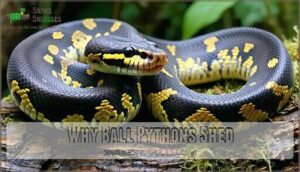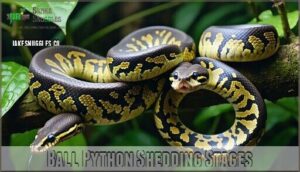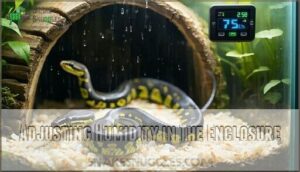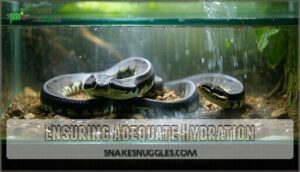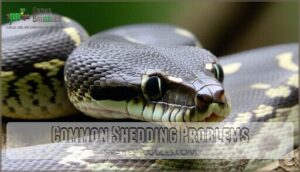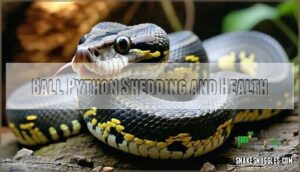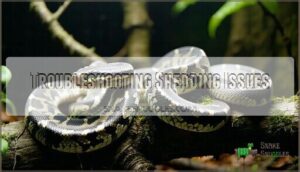This site is supported by our readers. We may earn a commission, at no cost to you, if you purchase through links.
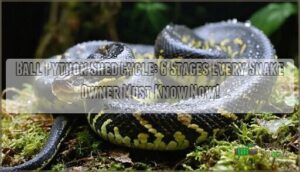 Your ball python’s shed cycle occurs every 4-6 weeks and unfolds in six distinct stages.
Your ball python’s shed cycle occurs every 4-6 weeks and unfolds in six distinct stages.
First, your snake’s eyes turn bluish (the "blue phase"), followed by clearing up before shedding begins.
During this time, you’ll notice your normally chill pet becoming irritable and hiding more—they’re not being rude, just uncomfortable in their old skin.
Proper humidity (60-80%) is essential for a successful shed, which should come off in one complete piece.
Think of it as your snake slipping out of a snug sweater.
Getting the humidity right can mean the difference between a smooth shed and problematic stuck patches.
Table Of Contents
- Key Takeaways
- Why Ball Pythons Shed
- The Shedding Process
- Creating The Optimal Shedding Environment
- Common Shedding Problems
- Ball Python Shedding and Health
- Troubleshooting Shedding Issues
- Frequently Asked Questions (FAQs)
- Can you leave a heat lamp on 24/7 for ball python?
- What are the stages of snake shedding?
- What are the signs of a reptile going through a shed cycle?
- How often will a ball python shed?
- How long do snakes hide while shedding?
- Does shedding mean a snake is growing?
- Why is my ball python shedding in pieces?
- How often do baby ball pythons shed?
- Do ball pythons hide more during shedding?
- Can environment stress affect shedding frequency?
- Conclusion
Key Takeaways
- Keep humidity levels between 60-80% to ensure a smooth shedding process and prevent stuck sheds.
- Watch for signs like darkened skin, blue eyes, and reduced activity to know your ball python is entering its shedding cycle.
- Provide a humid hide, rough surfaces, and a water dish for soaking to help your snake shed effectively.
- Monitor shed frequency as a health indicator—sudden changes may signal stress, dehydration, or enclosure issues.
Why Ball Pythons Shed
Your ball python isn’t trying on a new fashion trend when it sheds—it’s simply growing and needs to remove its old skin to accommodate its expanding body.
Just like you can’t squeeze into your childhood clothes forever, your scaly friend outgrows its skin and undergoes ecdysis (shedding) every 4-6 weeks as an adult or more frequently as a juvenile, which is a natural process related to its growth and development, particularly during periods of expanding body size.
Ball Python Shedding Timeline
Every ball python follows a predictable shed cycle that repeats throughout their lives.
Understanding this timeline helps you provide proper care during these vulnerable periods.
- Juvenile pythons shed every 4-6 weeks due to rapid growth
- Adult pythons shed less frequently, typically every 6-8 weeks
- Complete cycle spans 7-14 days from first signs to finished shed
Seasonal changes and health factors can occasionally shift this timeline, so monitor your snake’s individual patterns.
How Often Do Ball Pythons Shed Their Skin?
Following the natural rhythm of your ball python’s growth, shedding frequency varies dramatically by age.
Juveniles shed every 3-4 weeks during rapid development, while adults typically shed every 6-8 weeks or even less frequently (10-14+ weeks in winter months).
Your snake’s growth rate, diet influence, and overall health impact this cycle, as well-fed pythons shed more often—it’s their body’s response to expansion.
Monitor this shedding frequency as a health indicator; consistent patterns suggest proper care, while sudden changes might signal problems.
Seasonal variation is normal, especially in mature snakes, and disruptions in this cycle can indicate improper humidity levels, such as those discussed at improper humidity levels, which may require attention to prevent issues.
What to Expect During Shedding
Now that you understand your ball python’s shedding frequency, let’s talk about what you’ll actually see during the process.
Your snake will display clear visual cues when entering its shedding cycle.
Watch for dull, darkened skin, milky-blue eyes during the "blue phase," decreased appetite, and more hiding behavior.
These preshed symptoms typically begin 1-2 weeks before the actual shed.
The complete shedding process lasts about 10-14 days, ending with a brighter, refreshed post-shed appearance, which is a result of the snake’s shedding cycle.
The Shedding Process
You’ll witness your ball python undergo a remarkable transformation called ecdysis, where it sheds its entire skin in one piece to accommodate growth.
During this 1-2 week process, your snake will display telltale signs like dulling skin and blue eyes, much like how we humans might look a bit "off" before a makeover day, which can be a sign of the snake’s preparation for ecdysis.
Ball Python Shedding Stages
While your ball python progresses through its shedding cycle, you’ll witness six distinct stages that transform your snake’s appearance and behavior.
During the complete shedding process, your python will experience:
- Pre-Shed Signs: Dull, darkened skin and reduced activity
- Blue Phase: Milky eyes lasting 4-7 days as fluid separates skin layers
- Clearing Stage: Eyes return to normal as shedding approaches
This natural cycle typically spans 10-14 days, with each stage signaling your python’s progression toward a fresh, vibrant appearance.
Ball Python Shedding Behavior
During shedding, your ball python transforms its behavior dramatically.
Shedding turns your ball python into a secretive, nocturnal artist, crafting its transformation in the quiet safety of the night.
Watch for these key changes:
- Increased hiding – They’ll seek secluded, dark spaces while feeling vulnerable
- Feeding refusal – Many stop eating completely until after shedding
- Rubbing behavior – Notice them strategically rubbing against rough surfaces
- Nocturnal activity – Shedding often occurs at night when they feel safer
This behavior monitoring helps you understand their natural shedding cycle.
How to Identify Shedding Issues
While your ball python moves through shedding phases, watch for trouble signs.
Fragmented sheds or pieces coming off in patches often signal humidity problems. Retained eyecaps appear as cloudy caps stuck over eyes after the main shed. Skin discoloration or abnormal behavior like excessive rubbing might indicate shedding issues.
A key component of pre-shedding preparation is to increase humidity levels. If your snake seems distressed or hasn’t completed shedding within 72 hours after the blue phase, it’s time to intervene with appropriate humidity adjustments to prevent further issues, ensuring the snake’s health and well-being.
Creating The Optimal Shedding Environment
You’ll need to create the perfect environment for your ball python’s shed cycle by maintaining 60-80% humidity and providing rough surfaces for them to rub against.
Your scaly friend will thank you with a complete, one-piece shed—much more impressive than the patchy way some of us shed our winter layers, which can be a one-piece process for your pet.
Adjusting Humidity in The Enclosure
When your ball python enters shed phase, humidity becomes your best friend! Maintaining proper moisture levels guarantees a smooth, healthy shed cycle.
- Monitor humidity levels with a digital hygrometer (aim for 50-60%)
- Increase to 70-80% during active shedding periods
- Choose moisture-retaining substrates like coconut fiber or peat moss
- Mist enclosure daily but avoid soaking wet conditions
Think of humidity control as your snake’s personal spa treatment – they’ll thank you with a perfect shed! A humid hide can also help with shedding.
Providing a Safe Haven for Shedding
Now that you’ve mastered humidity control, let’s create the perfect retreat for your ball python during its vulnerable shedding process.
Your snake needs secure hides that feel like a cozy sanctuary. Choose a snug-fitting hide with a small entrance, placed in a quiet corner of the enclosure. To guarantee a comfortable and secure shedding environment, consider purchasing a reptile hide box.
Snug fit
Quiet corner
Natural substrate
Reduce handling during this time and monitor behavior closely to prevent shedding problems.
Ensuring Adequate Hydration
While a proper hide gives your snake security, proper hydration works behind the scenes for successful shedding.
Always provide a water bowl large enough for partial soaking – your python should be able to fit one-third of its body comfortably.
Replace water daily and watch for hydration signs like elastic skin. Proper bowls provide essential drinking access.
During shedding, increase substrate moisture slightly and consider gentle misting every other day. These simple steps prevent stuck sheds and reduce environmental stress.
Common Shedding Problems
You’ll likely encounter shedding problems with your ball python at some point, from stuck shed to those pesky retained eye caps that make your snake look like it’s wearing tiny contact lenses.
Even with perfect care, these issues can happen to any snake owner, but knowing how to address them quickly will keep your scaly friend healthy and comfortable.
Stuck Sheds and Eye Caps
Now that your humidity management is on point, let’s tackle those inevitable hiccups in the shedding process.
Even with good care, your ball python might experience incomplete sheds or retained eye caps. These shedding problems signal potential humidity issues that need addressing.
For persistent shedding issues, consider using specialized shedding products.
When trouble strikes, watch for:
- Cloudy, persistently opaque eyes after shedding
- Patches of stuck shed, especially around the head
- Changed behavior or reluctance to eat.
Identifying these early saves you and your scaly friend unnecessary stress.
Resolving Shedding Issues
When faced with ball python shedding issues, quick action is essential.
Building on our discussion of stuck sheds and eye caps, here’s how to resolve common problems:
- Create a humidity box – Line a container with damp paper towels for 1-2 hours of soak time
- Gentle lukewarm baths – 10-15 minutes can loosen stuck shed naturally
- Cotton swab technique – Carefully roll moistened swabs over retained eye caps
- Professional intervention – Consult a reptile vet for persistent shedding problems
Don’t panic when facing incomplete sheds—these simple solutions usually solve stuck shed issues quickly.
You can also maintain proper humidity levels to prevent shedding issues.
Preventing Dehydration
Now that you’ve learned how to address stuck sheds, let’s tackle their primary cause – dehydration.
Your ball python’s hydration is critical during shedding cycles.
Maintain a large water bowl for drinking and humidity.
Lightly mist the enclosure using proper techniques when humidity drops below 50%.
Choose moisture-retaining substrates like coconut fiber or cypress mulch.
For severe cases, offer 10-15 minute soaks in lukewarm water to ease environmental stress and prevent those frustrating stuck sheds.
Ball Python Shedding and Health
Your ball python’s shedding process offers valuable insights into its overall health, serving as a window into potential issues that might otherwise go unnoticed.
You’ll want to monitor each shed cycle carefully, as problems like incomplete sheds or irregular timing can signal dehydration, parasites, or other conditions that need your attention, related to its overall health.
Shedding and Parasite Removal
While shedding problems can be a headache, your ball python’s regular shed cycle serves a essential purpose beyond growth—it’s nature’s parasite removal system.
During shedding, your snake discards external parasites like mites and ticks along with its old skin.
This natural defense mechanism helps keep your pet healthy and parasite-free. Watch for signs of mite infestation (tiny black/red dots) or irregular shedding patterns, which might indicate internal parasites affecting your ball python’s health.
Feeding During Shedding
During your ball python’s shed cycle, feeding becomes a delicate matter. Most snakes naturally fast while shedding, which is perfectly normal.
Here’s what to know about feeding during shedding:
- Avoid offering food when eyes are blue or skin is dull
- Respect refusal—it’s instinctual, not stubbornness
- Wait 48-72 hours after complete shed before offering prey
- Select appropriate prey size for post-shed meals
- Maintain water availability for proper hydration throughout
Don’t worry—this temporary fast won’t harm your healthy snake. It’s essential to remember that snakes have different needs during shedding, and respecting these needs is crucial for their well-being, ensuring a successful shed and maintaining proper hydration throughout, which is vital for a smooth recovery.
Maintaining a Humid Environment
While your ball python takes a feeding break, maintaining ideal humidity becomes your top priority for a successful shed.
You’ll need to keep humidity levels between 60-80% for healthy shedding. Monitor this daily with a reliable hygrometer placed at mid-level in the enclosure.
| Humidity Element | Function | Recommendation |
|---|---|---|
| Substrate Choice | Moisture retention | Coconut fiber/cypress mulch |
| Water Bowl | Passive humidity | Large, wide placement |
| Misting Technique | Direct moisture | Light spray 1-2× daily |
| Humid Hide | Microclimate | Moss-filled hide box |
To achieve the right environment, consider the misting technique and the use of a humid hide, as these elements contribute significantly to maintaining the optimal humidity range.
Troubleshooting Shedding Issues
When your ball python’s shed isn’t going smoothly, you’ll need to act quickly to prevent potential health issues.
You can solve most shedding problems with proper humidity adjustments or a gentle soak, but some situations might have you wishing snakes came with instruction manuals.
Why is My Ball Python Not Shedding?
Panic rises when your ball python breaks its regular shedding schedule.
Environmental issues like low humidity (under 50%) often cause shedding problems.
Underlying illnesses, improper diet, and stress factors can also disrupt this natural process.
Check if your enclosure maintains proper temperature gradients (75-95°F) and humidity levels (60-80%).
Genetic predisposition may affect shedding frequency too, especially in certain morphs.
If your snake shows signs of stuck shed or hasn’t shed in 3+ months, these aren’t just minor shedding issues—they require closer attention to identify the root cause of the problem, which could be related to environmental issues.
How to Encourage Shedding
Your ball python’s stubborn old skin needs proper encouragement to shed naturally.
Here’s how to help:
- Increase humidity to 60-80% by misting the enclosure daily
- Provide a humid hide with damp sphagnum moss for your slithery friend
- Offer a shallow water dish large enough for soaking
- Introduce rough surfaces like branches or rocks for rubbing
Maintaining proper substrate moisture and reducing handling during shedding will also minimize stress and prevent stuck shed problems.
When to Consult a Veterinarian
Despite your best efforts, certain shedding issues require professional attention. Contact your vet immediately if you notice infection signs like stuck shed, retained eye caps, or discharge around the vent.
Abnormal sheds accompanied by weight loss, lethargy, or behavioral changes also warrant vet consultation. Don’t wait if your snake misses several feeding sessions or can’t move parts of its body normally.
Persistent problems with shedding often indicate underlying snake health concerns that need expert diagnosis. Remember, annual check-ups help catch potential issues before they become serious—think of your vet as your snake’s health detective, uncovering what your eyes might miss.
Frequently Asked Questions (FAQs)
Can you leave a heat lamp on 24/7 for ball python?
No, you shouldn’t leave a heat lamp on 24/7 for your ball python.
They need temperature variation between day and night.
Use a timer to create proper day/night cycles for better health.
What are the stages of snake shedding?
Snake shedding involves four stages: pre-shed (darkened skin, reduced activity), blue phase (milky eyes, 4-7 days), clearing phase (eyes normalize), and actual shedding (rubbing against surfaces to remove skin in one piece).
What are the signs of a reptile going through a shed cycle?
You’ll notice dull, darkening skin, blue-tinged cloudy eyes, and reduced activity.
They may skip meals and act skittish.
It’s like a reptile’s version of a bad hair day—just give them space and humidity!
How often will a ball python shed?
Ball pythons shed sporadically, syncing with their growth spurts.
Juveniles shed every 4-6 weeks, while adults take it slower at 6-8 weeks or more.
Think of it as their version of wardrobe upgrades!
How long do snakes hide while shedding?
During shedding, snakes often hide for 9-14 days, avoiding stress and predators.
They’re like introverts recharging—less active, refusing food, and staying tucked away until their new skin is ready for its debut.
Does shedding mean a snake is growing?
Like outgrowing an old pair of jeans, shedding often signals your snake is growing.
It’s their way of making room for new, larger skin as they mature or recover from injuries.
Why is my ball python shedding in pieces?
Your python’s shedding in pieces likely means low humidity or dehydration.
Boost enclosure humidity to 60-80%, add a moist hide, and make certain fresh water is available.
Think of it as their version of a bad hair day!
How often do baby ball pythons shed?
It’s funny how baby ball pythons seem to outgrow their skin faster than kids outgrow shoes.
They shed every 3-4 weeks, thanks to their rapid growth, so keep humidity perfect for smooth shedding.
Do ball pythons hide more during shedding?
Yes, during shedding, they tend to hide more.
It’s their way of staying safe when their vision’s impaired.
Think of it like taking a sick day—you want peace, quiet, and no interruptions!
Can environment stress affect shedding frequency?
Stressful environments, like poor humidity or excessive noise, can throw off a snake’s shedding rhythm.
It’s like trying to relax in chaos—impossible!
Keep their habitat calm and cozy to maintain a healthy shedding cycle.
Conclusion
Mastering your ball python’s shed cycle might feel like discovering a hidden secret, but it’s simpler than it sounds.
With the right humidity, a cozy setup, and regular observation, you’ll help your snake slip out of its old skin like a pro.
Check for stuck sheds or signs of discomfort, and don’t hesitate to adjust the enclosure as needed to ensure smooth and scale-perfect success.
By understanding these six shedding stages, you’re setting your scaly friend up for success!
- http://rspb.royalsocietypublishing.org/content/279/1740/3049
- https://www.sciencedirect.com/science/article/pii/S0944200607000372?via%3Dihub
- https://www.quora.com/What-should-the-humidity-be-for-my-ball-python-when-shedding-I-think-she-just-started-going-into-the-process-because-her-eyes-are-blue-and-her-skin-is-dull-and-it-wasnt-5-days-ago-when-I-fed-her
- https://community.morphmarket.com/t/humidity-levels/40133
- https://www.youtube.com/watch?v=1UTYX-L4hDA

